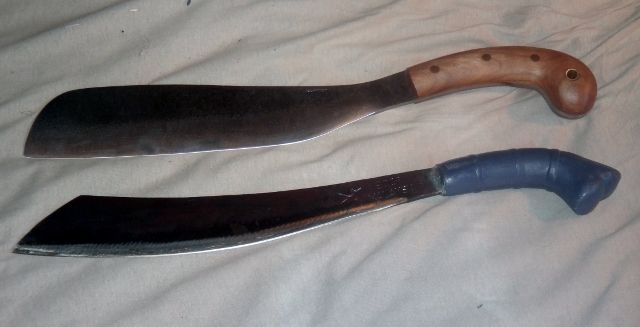- Parang : Condor
- Parang : Bidor
This review consists of :

Knives :
This review consists of : |

|
These parangs were made semi-famous, or at least introduced to the West through Ray Mears who introduced them in use and function in several of his documentaries / bushcraft works. They have a deep history in Malaysia and can even be bought direct from there through OutDoor Dynamics. In general most commentary on them is positive such as the following perspective from BushCraft USA : Tramontina Bolo vs. Bidor Parang.
The company started out a fairly small local business but has expanded significantly and has a fairly modern and significant facility to meet growing demand. There is a very nice detailed overview of the facility by my-rainforest-adventures.com which shows :
General specifications :
This blade specifically :
Note this was used, it was sharpened a few times hence the secondary bevel.
A few issues :
To clarify :
The point is thin and sharp and this is one of the polarizing issues on parangs. A very "sticky" point is nice to have for cutting/penetration and simply being able to stick in wood to move it around. However a very wide tip prevents that sticking when cuts do not go exactly as desired and also works nicer as a hammer and a shovel. It is simply a matter of what you want, they come in both styles.
In regards to consistency of design, it is very well made for the purpose for which it is commonly used which is :
In some detail :
This gives the blade nice power on a snap cut, allowing it to be used for long periods of time with little handle abrasion. The steel is well suited to cutting wood/vegetation, easily able to take repeated impacts and is very easy to restore though high grindablity in accidental hard impacts.
While it is functional in the as-delivered state there are a few issues which need to be resolved to make it more suitable for local vegetation and to simply optimize it for wood cutting. The first step was to even out the grind.
A piece of a 200X King stone and 15 minutes reground the primary bevel to a clean apex. This did not significantly thin the bevel and make the angles lower it simply evened out the grind. This bevel was left with a heavy convex grind which reaches its final apex angle of about 17 dps at 0.030" thick.
By evening out and making the grind consistent the blade will be
The grip is both a high point as it is :
However it is also round and slick and the single pin + epoxy is a cause for concern. Care needs to be taken though to realize that this parang is designed and used daily with continuous use with low to moderate force. In such use a smooth grip is needed as otherwise it would be too abrasive.
In order to make it more suitable for heavier an intermittent chopping two small flats were ground onto the handle which left it more oval with a 30% difference between th thickness (1") and the width (1.3"). The grip was also sanded with very coarse sandpaper to provide a more secure grip.
On 3/8" hemp :
On carving wood compared to the #1260 Mora :
In a chopping comparison against a slightly modified Fiskars Sportsman Axe the XXX had XX% of the ability of the hatchet.
Ergonomics :
Security :
Durability :
Construction :
Miscellaneous :
The sheath has numerous problems. To be clear, the sheath is sold by the seller directly (Machete Specialists) it isn't from Bidor :
As noted in the image at the right, because the sheath has no welt the edge comes in direct contact with the stitching and it is cut through almost instantly before the knife is even used.
While that design of a loop is common which allows it to come in contact with the edge, the loop on this sheath is completely non functional as it doesn't secure the blade at all as it is so loose. In fact with the loop snapped closed the blade can just be drawn and it will cut right through the loop with no issues.
As boxed the primary grind on these blades is likely to be very rough, it has to be kept in mind that these are mass produced blades and locally cost only about ten dollars. Before they can be readily sharpened, if a high sharpness is required then the bevel needs to be evened out and cleanly apexed as noted in the above. While the blade can be filed, it is on the hard side and just possible and needs to be viced and ideally use a two handed draw filing or similar technique.
Once the bevel has been properly set and is even and continuous as noted in the image on the right it is very easy to maintain and sharpen as 5160 is very easy to grind and can be worked easily even with basic and inexpensive abrasives. However if a very high sharpness is desired (push cutting newsprint and similar) then this would be a challenging blade to try to achieve it as it is water quenched and likely auto-tempered 5160 and thus is unlikely to have the optimal type of microstructure which makes that level of sharpness easy to achieve.
Overview :
Comments can be emailed to Please Use the Forum or by posting to the following thread :
and/or the YouTube Playlist.
Most of the pictures in the above are in the PhotoBucket
album.
| Last updated : | |
| Originally written: |